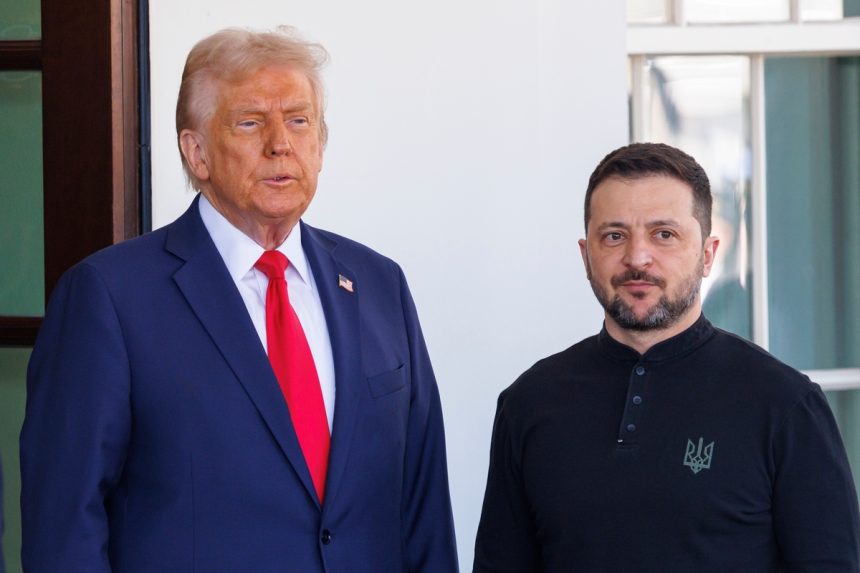In a pivotal moment that could shape Ukraine’s future and Europe’s security, President Volodymyr Zelenskyy gathered with top European leaders at the White House on Monday to present a unified front to U.S. President Donald Trump. Their goal: secure Ukraine’s survival and push for a lasting resolution to Russia’s war. The high-stakes talks followed Trump’s closed-door meeting with Vladimir Putin, leaving Ukraine and its allies anxious about the path forward.
A Unified Front Arrives in Washington
In a rare and deliberate show of solidarity, key European leaders—including French President Emmanuel Macron, UK Prime Minister Keir Starmer, German Chancellor Friedrich Merz, Italian Premier Giorgia Meloni, and others—joined Zelenskyy at the White House. They were excluded from Trump’s recent summit with Putin and made it clear they wouldn’t be sidelined again.
“We understand that we shouldn’t expect Putin to voluntarily abandon aggression and new attempts at conquest,” Zelenskyy posted on X. “That is why pressure must work, and it must be joint pressure – from the United States and Europe.”
Their mission: ensure Ukraine’s interests aren’t sacrificed in backroom diplomacy and prevent any future threats to European stability.
Tensions Over Past Remarks and Future Concessions
Zelenskyy’s last solo meeting with Trump in February was fraught with criticism over his “lack of gratitude” for U.S. aid. Now, accompanied by Europe’s political heavyweights, the Ukrainian leader is hoping to shift the tone.
However, Trump’s recent social media post hinted at pressure on Zelenskyy to accept concessions. “President Zelenskyy of Ukraine can end the war with Russia almost immediately, if he wants to,” Trump wrote, adding, “NO GOING INTO NATO BY UKRAINE.”
Zelenskyy rebutted calmly: “We all share a strong desire to end this war quickly and reliably… Peace must be lasting,” he posted, referring to Russia’s previous aggression in Crimea and Donbas.
Behind Closed Doors: Security Guarantees and Diplomatic Pressure
European officials arrived with a singular objective: security for Ukraine that lasts beyond ceasefires. Some are advocating for NATO-like guarantees—even if formal NATO membership is off the table.
“Clearly there are no easy solutions when talking about ending a war and building peace,” said Italian Premier Giorgia Meloni. “We have to explore all possible solutions to guarantee peace, to guarantee justice, and to guarantee security for our countries.”
One proposal being floated by Trump’s special envoy, Steve Witkoff, involves NATO-style commitments to defend Ukraine if attacked, even without official NATO status. But that may not be enough to ease Zelenskyy’s concerns, especially with Putin still demanding full control of Donbas.
The Ceasefire Dilemma and Trump’s Peace-First Approach
Following his meeting with Putin in Alaska, Trump stated that a ceasefire wasn’t required to begin peace negotiations—a stance aligned with Russia’s preference. European leaders worry this could leave Ukraine vulnerable.
Zelenskyy, meanwhile, continues seeking a trilateral summit with Trump and Putin to negotiate sensitive territorial matters directly. According to one Ukrainian official, “Zelenskyy needs to prevent a scenario in which he gets blamed for blocking peace talks by rejecting Putin’s maximalist demand.”
A Diplomatic Tightrope for Ukraine’s Leader
Zelenskyy faces mounting pressure: protect Ukrainian territory, avoid isolation, and secure security guarantees—all while managing an unpredictable U.S. partner. Monday’s talks included a prior meeting with Trump’s envoy, Keith Kellogg, to align battlefield updates with diplomatic momentum.
The meeting may be a turning point—or a diplomatic minefield. Ukraine continues to suffer, with Sunday’s Russian drone strike on Kharkiv killing seven civilians, underscoring the urgent need for real progress.
As Trump seeks to carve a legacy as a peacemaker, Zelenskyy walks a fine line—welcoming peace but resisting a bad deal. “Peace must be lasting,” he emphasized again. The European leaders, standing firmly at his side, hope that their joint presence will nudge the U.S. toward a fair solution. But as negotiations unfold, one truth remains: the stakes for Ukraine, and global stability, have never been higher.






